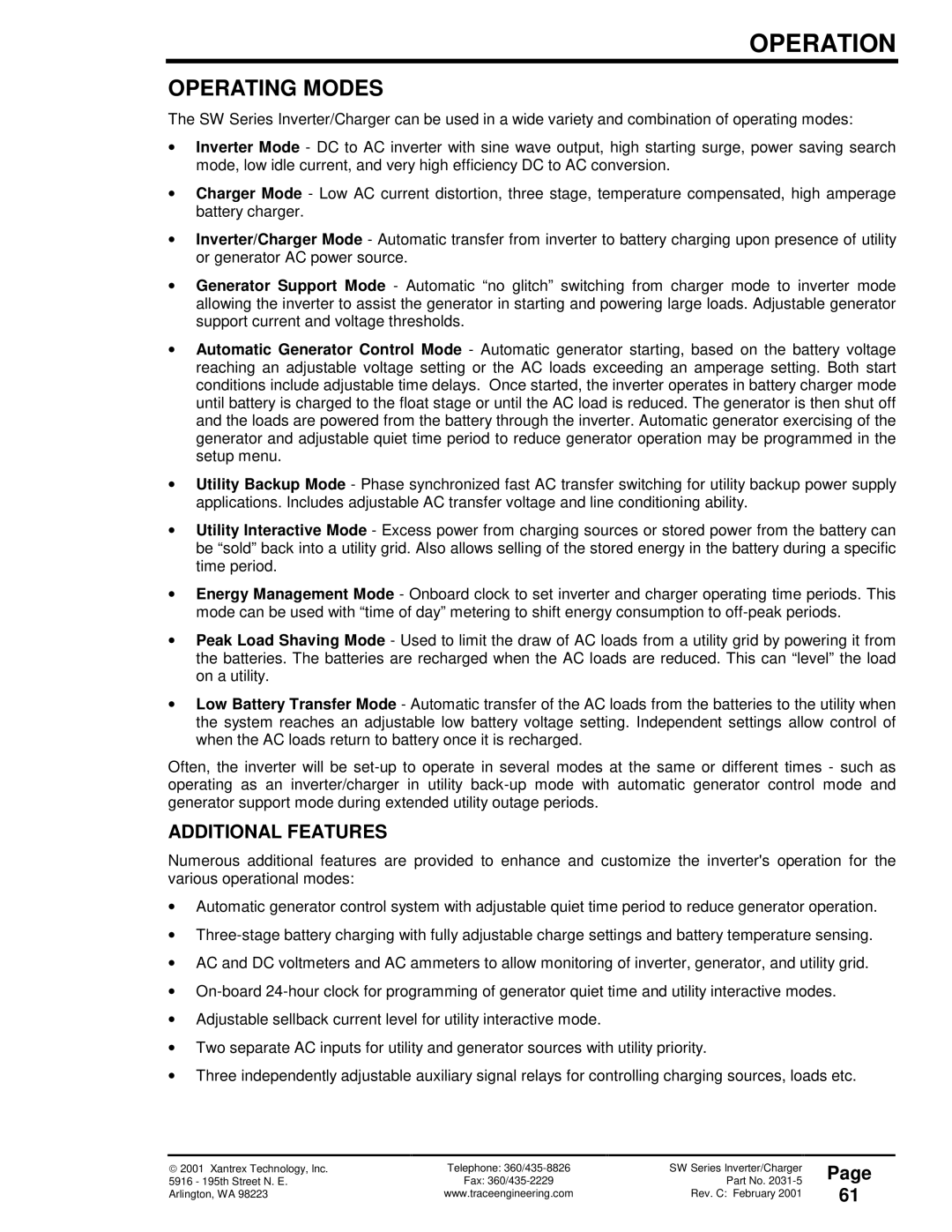
OPERATION
OPERATING MODES
The SW Series Inverter/Charger can be used in a wide variety and combination of operating modes:
•Inverter Mode - DC to AC inverter with sine wave output, high starting surge, power saving search mode, low idle current, and very high efficiency DC to AC conversion.
•Charger Mode - Low AC current distortion, three stage, temperature compensated, high amperage battery charger.
•Inverter/Charger Mode - Automatic transfer from inverter to battery charging upon presence of utility or generator AC power source.
•Generator Support Mode - Automatic “no glitch” switching from charger mode to inverter mode allowing the inverter to assist the generator in starting and powering large loads. Adjustable generator support current and voltage thresholds.
•Automatic Generator Control Mode - Automatic generator starting, based on the battery voltage reaching an adjustable voltage setting or the AC loads exceeding an amperage setting. Both start conditions include adjustable time delays. Once started, the inverter operates in battery charger mode until battery is charged to the float stage or until the AC load is reduced. The generator is then shut off and the loads are powered from the battery through the inverter. Automatic generator exercising of the generator and adjustable quiet time period to reduce generator operation may be programmed in the setup menu.
•Utility Backup Mode - Phase synchronized fast AC transfer switching for utility backup power supply applications. Includes adjustable AC transfer voltage and line conditioning ability.
•Utility Interactive Mode - Excess power from charging sources or stored power from the battery can be “sold” back into a utility grid. Also allows selling of the stored energy in the battery during a specific time period.
•Energy Management Mode - Onboard clock to set inverter and charger operating time periods. This mode can be used with “time of day” metering to shift energy consumption to
•Peak Load Shaving Mode - Used to limit the draw of AC loads from a utility grid by powering it from the batteries. The batteries are recharged when the AC loads are reduced. This can “level” the load on a utility.
•Low Battery Transfer Mode - Automatic transfer of the AC loads from the batteries to the utility when the system reaches an adjustable low battery voltage setting. Independent settings allow control of when the AC loads return to battery once it is recharged.
Often, the inverter will be
ADDITIONAL FEATURES
Numerous additional features are provided to enhance and customize the inverter's operation for the various operational modes:
•Automatic generator control system with adjustable quiet time period to reduce generator operation.
•
•AC and DC voltmeters and AC ammeters to allow monitoring of inverter, generator, and utility grid.
•
•Adjustable sellback current level for utility interactive mode.
•Two separate AC inputs for utility and generator sources with utility priority.
•Three independently adjustable auxiliary signal relays for controlling charging sources, loads etc.
2001 Xantrex Technology, Inc. | Telephone: | SW Series Inverter/Charger |
5916 - 195th Street N. E. | Fax: | Part No. |
Arlington, WA 98223 | www.traceengineering.com | Rev. C: February 2001 |
Page
61
